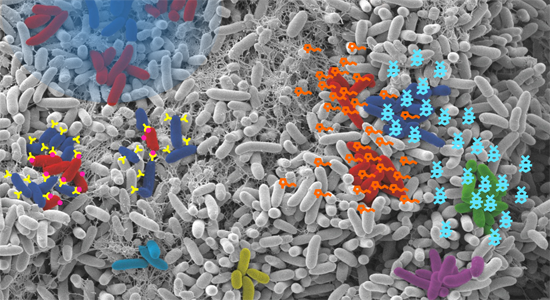Investigate the properties of bacterial communities – Biofilms
Project type: PUK, Bachelor, Master
Living in an organ ized society is very advantageous. It enables individuals to specialize and become experts in specific tasks, thus benefitting the whole community. This concept applies not only to humans, but also microbes. Most bacteria live in so-called biofilm communities. In these communities, they unite forces and produce an extracellular matrix which encases them and acts as a shield from predators. The generation of local niches and detention of enzymes and metabolites benefits all the members of the community. As the community grows and becomes more heterogeneous, the emergent properties support a large degree of specialization. Traditionally, bacteria have been studied in planktonic cultures; in recent years, the focus has shifted to biofilms. Studying biofilms has shown that the spatial rigidity and community structure is of great evolutionary, ecological, biotechnological, and clinical relevance.
ized society is very advantageous. It enables individuals to specialize and become experts in specific tasks, thus benefitting the whole community. This concept applies not only to humans, but also microbes. Most bacteria live in so-called biofilm communities. In these communities, they unite forces and produce an extracellular matrix which encases them and acts as a shield from predators. The generation of local niches and detention of enzymes and metabolites benefits all the members of the community. As the community grows and becomes more heterogeneous, the emergent properties support a large degree of specialization. Traditionally, bacteria have been studied in planktonic cultures; in recent years, the focus has shifted to biofilms. Studying biofilms has shown that the spatial rigidity and community structure is of great evolutionary, ecological, biotechnological, and clinical relevance.
At Section of Microbiology, we work with various aspects of bacterial interactions and hence, are greatly interested in biofilms. We study the differences between planktonic and sessile biofilm-associated bacteria, how gene expression is altered, and multi-species communities. We also address why biofilms are more difficult to eradicate than their planktonic counterparts. This research is especially clinically relevant, as biofilm-formers tend to exhibit high tolerance towards antimicrobials and cause recalcitrant infections. Thus, biofilm research could enable novel treatment strategies.
If you want to study mechanistic and evolutionary aspects of how bacteria cooperate to form robust biofilms, then do not hesitate to contact us. We have a diverse range of ongoing projects, from analyzing how a biofilm environment can help generate new probiotics, to the exploitation of beneficial biofilms or even the eradication of unwanted biofilms. In addition, new projects are regularly initiated. If you have an interesting idea, we have the facility to support it. The lab applies a range of techniques, which commonly include growing biofilms in different model systems, genetic manipulation, studying gene expression, advanced epifluorescence and confocal microscopy and image analysis. We also collaborate with Rigshospitalet, the Faculty of Health (KU-Sund) and other clinical and biotech partners to address more specific questions.
Please contact us for more information and feel free to come by and have a chat about developing a project to match your interests.
Contact information:
Supervisor Associate professor Mette Burmølle, LINK TO PROFILE
E-mail: burmolle@bio.ku.dk
Address
Section of Microbiology
Universitetsparken 15, building 1, 1st floor
DK-2100 Copenhagen
Section of Microbiology

Contact
Section of Microbiology
Universitetsparken 15, build. 1, 1. floor
DK-2100 Copenhagen
 SUPERVISOR
SUPERVISOR
Professor Mette Burmølle
E-mail: burmolle@bio.ku.dk
